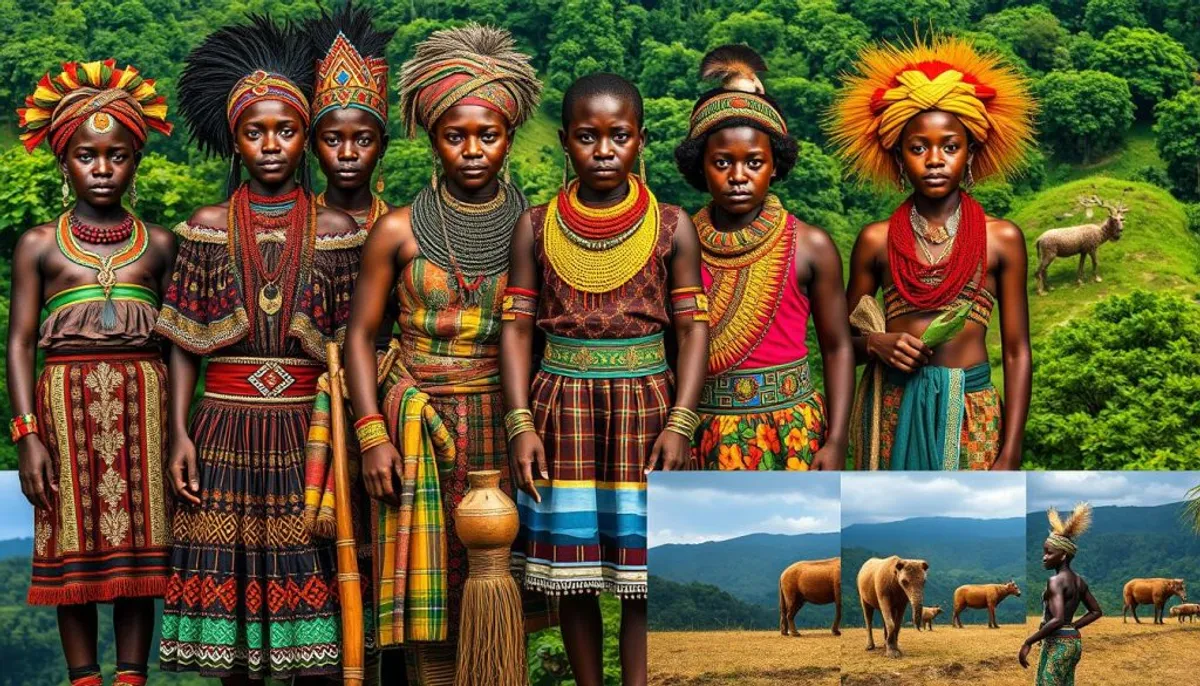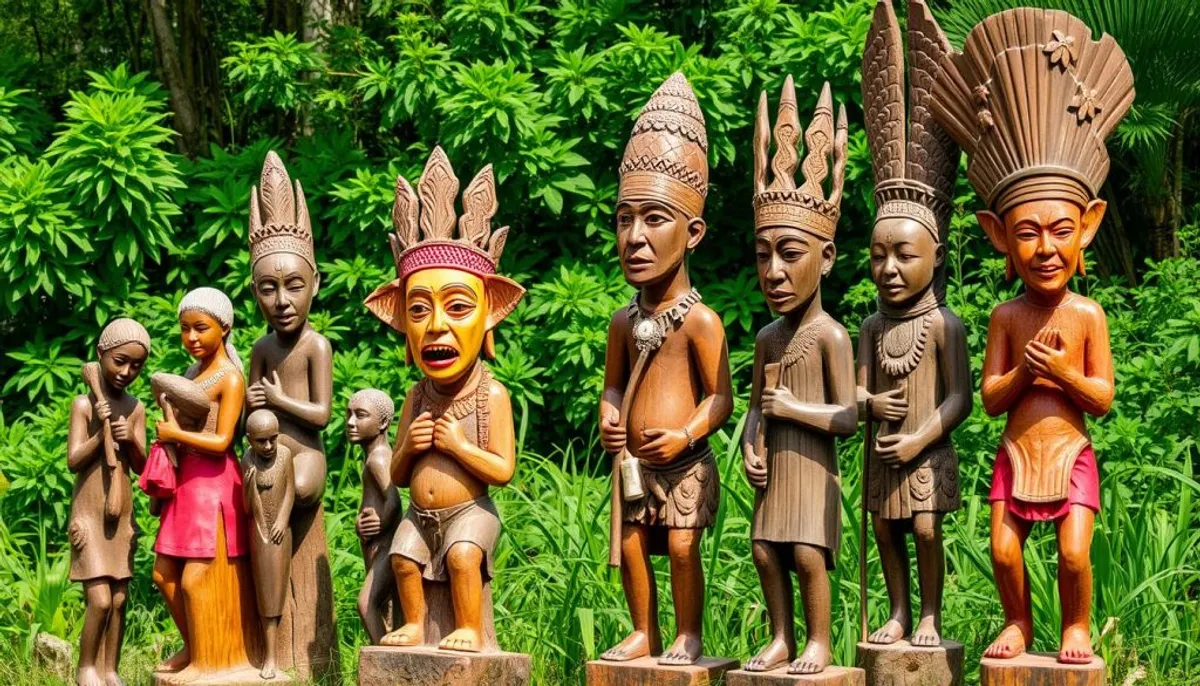The Congolese culture is a treasure of ethnic diversity and ancestral traditions. With a population of around 105 million inhabitants, the Democratic Republic of Congo is home to a mosaic of fascinating cultures. This vast country in Central Africa is a melting pot of over 450 languages and ethnic groups, each adding its unique touch to the Congolese cultural heritage.

The Congo stands out for its exceptional linguistic richness. Although French is the official language, spoken by more than 80% of the population aged over 7, local languages remain deeply rooted in daily life. This linguistic diversity reflects the complexity and richness of Congolese traditions, which have managed to withstand external influences and contemporary challenges.
From savannas to tropical forests, and the majestic Congo River, each region of the country is home to unique cultural expressions. The arts, music, dance, cuisine, and spiritual practices testify to the vitality of Congolese culture. Despite the challenges, the Congolese people continue to celebrate and preserve their cultural heritage, making Congo a jewel of Africa.
The foundations of Congolese ethnic diversity
Congo-Kinshasa is distinguished by an unparalleled cultural richness, housing over 350 tribes. This ethnic diversity shapes the national identity, profoundly influencing the social and political life of the country.
The four major ethnic families
Congolese diversity is divided into four major families: pygmies, Bantus, East Africans, and Hamites. The pygmies, the first inhabitants of Congo, play a unique role in the national history. The Bantus, on the other hand, constitute the most populous group.

The linguistic richness of Congo
Ethnic diversity is manifested by the linguistic richness of Congo. There are about 450 Congolese languages, illustrating the cultural complexity of the country. French, the official language, coexists with Lingala, Tshiluba, Kikongo ya Leta, and Kingwana, recognized as national languages. Additionally, the landscapes of French Alps add a unique dimension to the culture and diversity of the country.
The heritage of indigenous peoples
The indigenous peoples, particularly the pygmies, have left a profound cultural legacy. Their traditions, ways of life, and ancestral knowledge continue to influence contemporary Congolese culture. However, they face significant challenges.
| Ethnic Family | Main Characteristics | Associated Languages |
|---|---|---|
| Pygmies | First inhabitants, hunter-gatherers | Diverse pygmy languages |
| Bantus | Majority group, farmers | Lingala, Kikongo, Tshiluba |
| East Africans | Swahili influences, herders | Swahili (Kingwana) |
| Hamites | Originating from the Northeast, pastoralists | Nilo-Saharan languages |
What is Congolese culture: arts and traditional expressions
Congolese culture is a true treasure of diverse artistic expressions. It finds its roots in ancestral traditions, flourishing through art, music, and dance.
Visual arts and sculptures
Congolese art is distinguished by its emblematic sculptures. The “nail fetishes” of the Vili, the Bembe figurines, and the Punu masks illustrate ancestral craftsmanship. These works, adorned with geometric patterns and spiritual symbols, reflect the deep soul of the Congolese people.

Music and its influences
Congolese music plays a central role in daily life. It accompanies ceremonies, rituals, and even work. Congolese rumba, recognized by UNESCO, has influenced many musical styles in Africa and around the world.
Traditional and modern dances
Traditional dances in Congo are closely linked to music. They express the cultural identity of the country and tell its history. Soukouss, derived from rumba, has given rise to modern urban dances that resonate with the Congolese youth.
| Artistic Expression | Characteristics | Influence |
|---|---|---|
| Sculptures | Geometric patterns, spiritual symbols | International recognition |
| Congolese music | Rumba, soukouss | UNESCO intangible cultural heritage |
| Dances | Traditional and modern | Identity and social expression |
Culinary and gastronomic traditions
Congolese cuisine is a mirror of the ethnic diversity of the country, with over 450 ethnic groups contributing to its richness. It is flavorful and varied, influenced by Belgian, French, Portuguese, and Arab traditions, and each dish can be considered a true artifact of the local culture.
Iconic dishes
Traditional dishes in Congo are characterized by the use of starches such as fufu, chikwange, and rice, often paired with meats or fish. Soso ya mwamba, a chicken in peanut and tomato sauce, and makayabu, salted cod, are particularly appreciated. Vegetables play a key role, especially fumbwa and pondu.
Agriculture and traditional hunting
Agriculture offers a wide variety of products. Hunting is an essential activity in certain regions. Meals are often served buffet-style, allowing everyone to customize their choices.
Traditional and ritual drinks
Local drinks include tangawisi, a mix of ginger and pineapple, lotoko, a corn and cassava alcohol, and Kwilu rum, a unique rum. Palm wine is also highly prized.
| Dish | Description | Main Ingredients |
|---|---|---|
| Fufu | Cassava dough | Cassava flour, water |
| Soso ya mwamba | Chicken in sauce | Chicken, peanuts, tomatoes |
| Pondu | Leaf stew | Cassava leaves, palm oil |
Spirituality and religious practices
The Democratic Republic of Congo is a country where religious diversity is particularly marked. With a population of over 100 million inhabitants, the country is dominated by Christianity. Nearly 80% of Congolese identify as Christians, with a majority being Catholic and a strong presence of Protestants and Evangelicals.
Islam and African traditional religions also play an important role. The Muslim community represents about 15% of the population. Ancestral beliefs, although declining, continue to influence the culture. Kimbanguism, a Christian movement, gathers about 10% of the faithful.
This diversity is reflected in the urbanization of the country. The number of churches has exploded, rising from 12,500 in 2015 to over 42,300 in 2022. In Kinshasa, the capital, there are more than 15,000 places of worship. This proliferation shows the importance of spirituality in the daily life of Congolese people, shaping their culture and identity.
Despite economic challenges, faith remains a central pillar of Congolese society. It offers comfort and hope, playing a significant role in education, public life, and the politics of the country.
RelatedRelated articles


